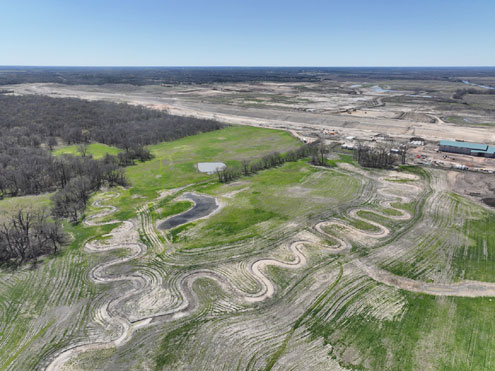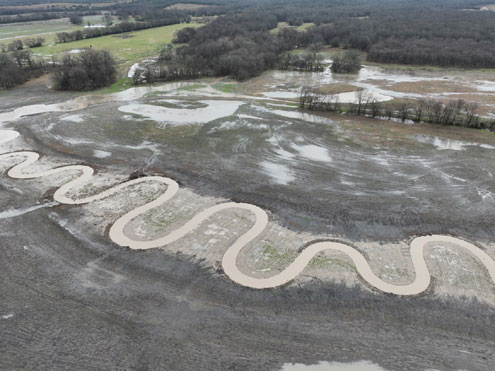Five streams revived as part of lake construction project
Ladonia, Texas -- Water is flowing through five new streams in North Texas this spring, bringing life back to areas impacted for decades by severe erosion and habitat loss.
Upper Trinity Regional Water District (UTRWD) restored the streams as part of environmental mitigation for future Lake Ralph Hall, Texas’s newest major lake under construction near Ladonia.
Reviving Natural Waterways with Innovative Restoration
UTRWD hired Texas Mitigation Solutions, a joint venture between Ecosystem Investment Partners and Mitigation Resources of North America, to assist with the mitigation project, restoring over 32,000 linear feet (just over six miles) of streams below the future lake’s Leon Hurse Dam. These streams were connected to the North Sulphur River and were disrupted when the river was channelized by farmers in the 1920s.

While the channelized North Sulphur River protected nearby farmland from flooding, this “straightening” of the river has caused massive erosion and has destroyed quality habitat. Multiple state highway bridges have been replaced over the decades because of the continued erosion. Now, the restored tributaries can once again
flow down their natural, curved paths.
“The lake itself will help slow the continued erosion downstream. The stream restoration will also help,” explained Ed Motley, UTRWD Project Manager for the Lake Ralph Hall project. “It provides lost river habitat and will improve water quality immediately downstream.”
Project Highlights: How the Streams Were Rebuilt
To create the streams, Texas Mitigation Solutions (TMS) worked with design engineers from Beaver Creek Hydrology to map the original paths of the North Sulphur River tributaries. They designed improved paths to reconnect the former North Sulphur River with four supporting tributaries that match their original locations as much as possible.
“I’d say 80% of the length is within the existing floodplain,” said TMS’ Site Construction Manager Dustin Fitzgerald.

The TMS team dug pathways for each tributary, incorporating bends to slow water flow, stabilize the banks and reduce erosion.
Fitzgerald explained, “Our team used bulldozers and
track hoes to cut the channel.” They removed soil to create a space for each tributary’s floodplain, an area that floods naturally during heavy rainfall.
The construction teams added live staked willows, biodegradable matting and native grasses to help establish the streams and provide habitat for local wildlife. Full flowing streams will range from around 1.5-3 feet deep and 8-10 feet wide.
“Woody riffles”—logs and gravel laid across the stream—were added to slow water flow. These protect the stream banks and raise the water table, promoting a healthier ecosystem. They also create pools of water ideal for frogs and bugs.
A challenging part of the project was the intricate process of connecting new tributaries to the main river—all during a rainy spring.
“We had to tie in streams to a main channel that was 18 to 20 feet deeper,” explained Fitzgerald. “We also had to dig these streams in very wet conditions. But now that everything is tied in, we’re just waiting for the rain to come and naturally fill the new streams.”
Long-Term Ecological Benefits and Continued Monitoring
The restoration effort is designed with long-term ecological benefits in mind. As part of the project’s final stages, crews are planting an additional 40,000 native trees, including sycamore and oak, to improve soil health and further stabilize the stream banks. Over the next seven years, TMS will monitor the area to ensure that the new streams function effectively and support the local ecosystem as planned.
“It’s been a rewarding project,” said Fitzgerald. “Seeing these streams come back to life and knowing the positive impact it will have on the surrounding environment makes all the hard work worth it.”
For more information on Lake Ralph Hall and ongoing stream restoration efforts, please visit lakeralphhall.com.
About the Upper Trinity Regional Water District
Upper Trinity is a regional water district created by the Texas Legislature in 1989 for the benefit of cities and utilities in the Denton County area. Its mandate is to develop regional plans for water services, and to provide both water and wastewater services on a wholesale basis to cities and utilities within its service area, including all of Denton County and portions of Dallas and
Collin Counties.


